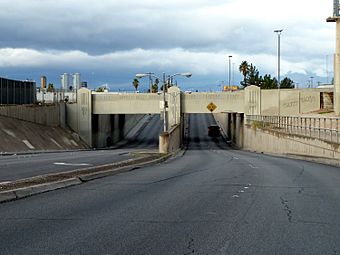Clark Avenue Railroad Underpass facts for kids
Quick facts for kids |
|
|
Clark Avenue Railroad Underpass
|
|
 |
|
| Location | W. Bonanza Road at the Union Pacific Railroad tracks Las Vegas, Nevada |
|---|---|
| Built | 1936 |
| Architect | Nevada Department of Highways and Union Pacific Railroad |
| Architectural style | Art Deco |
| NRHP reference No. | 03001509 |
| Added to NRHP | January 28, 2004 |
The Clark Avenue Railroad Underpass, also known as the Bonanza Underpass, is a special bridge and tunnel in Las Vegas, Nevada. It is an important landmark listed on the National Register of Historic Places. When it was built, it crossed a street called Clark Avenue. This street was later renamed Bonanza Road, which is why the underpass has two names. Today, this underpass is part of Nevada State Route 579.
Why the Underpass Is Important
This underpass was very important for people living in and around Las Vegas. Before it was built, crossing the Union Pacific Railroad tracks was quite dangerous. Trains were always moving, and there was no safe way for cars and people to get across.
The underpass created a safe path *under* the railroad tracks. This made it much easier and safer for people to travel between Las Vegas and the towns west of the city. It helped connect communities and made daily life much simpler for many people.
How the Underpass Was Built
The Bonanza Underpass was built in 1937. It was a project of the Works Progress Administration (WPA). The WPA was a special government program in the United States during the 1930s. Its goal was to create jobs for many people during a tough economic time called the Great Depression.
Over the years, the underpass has changed a bit. The biggest change happened when Bonanza Road was made wider. This project helped improve traffic flow in the area. The underpass is a great example of the Art Deco style of architecture, which was popular when it was built.

